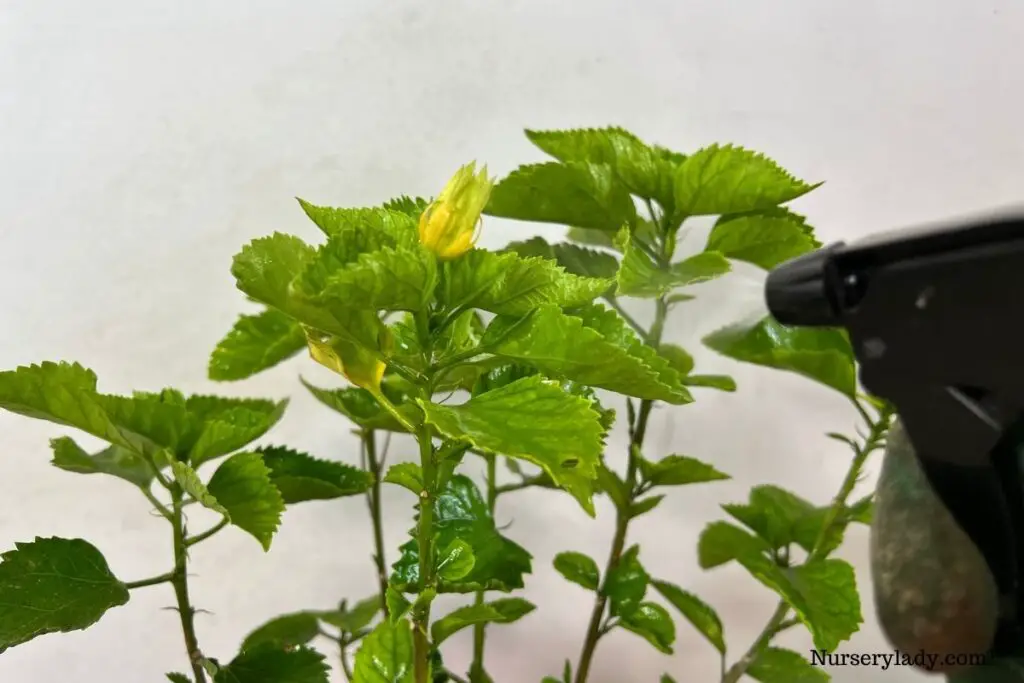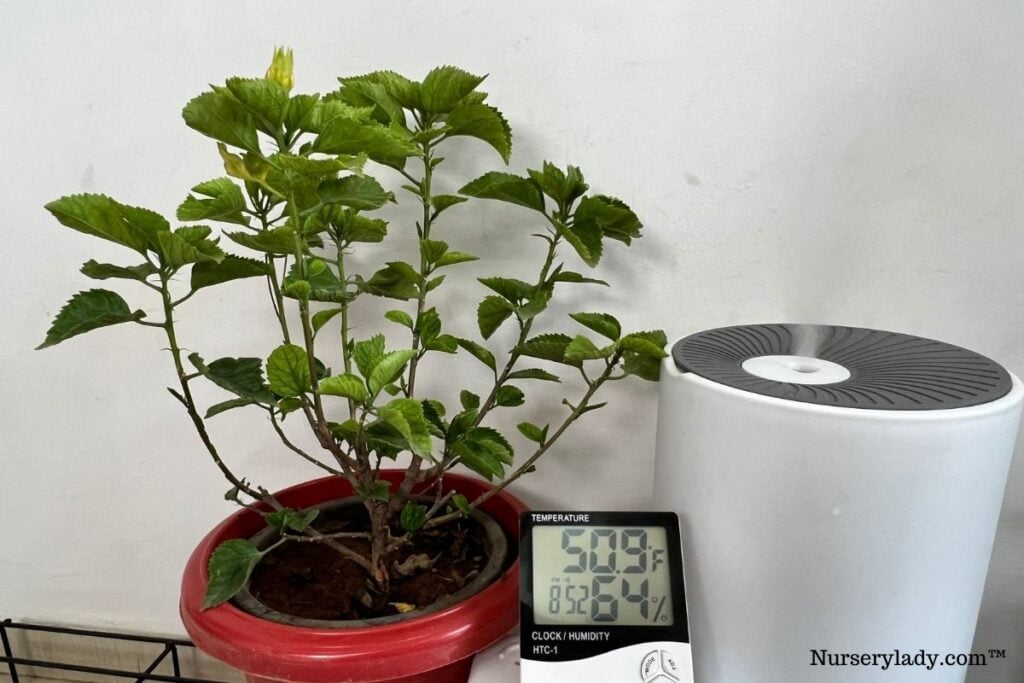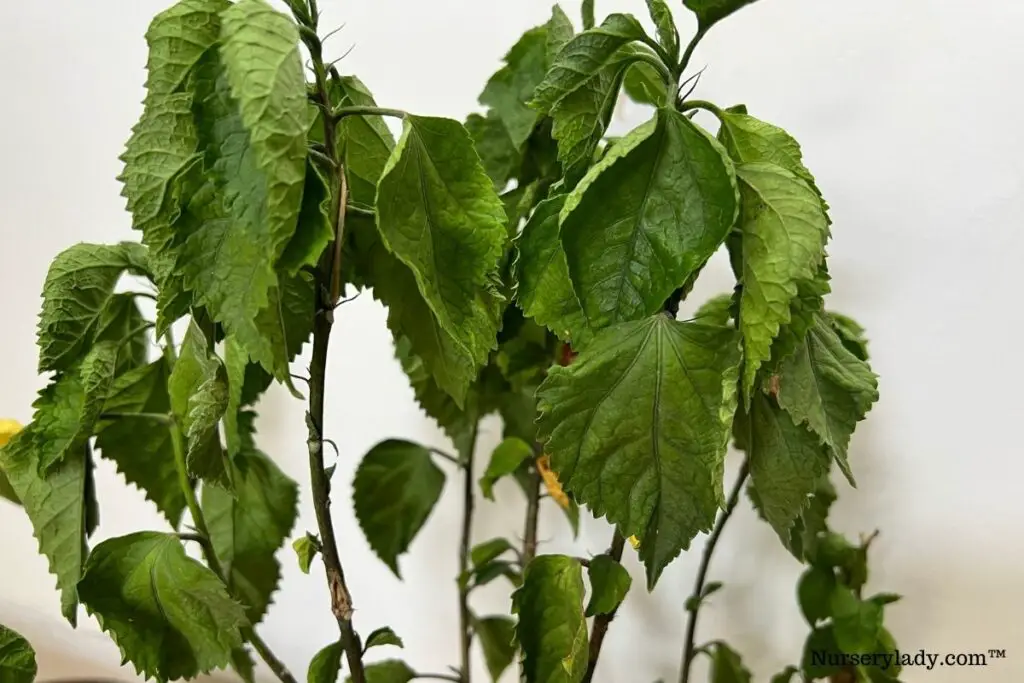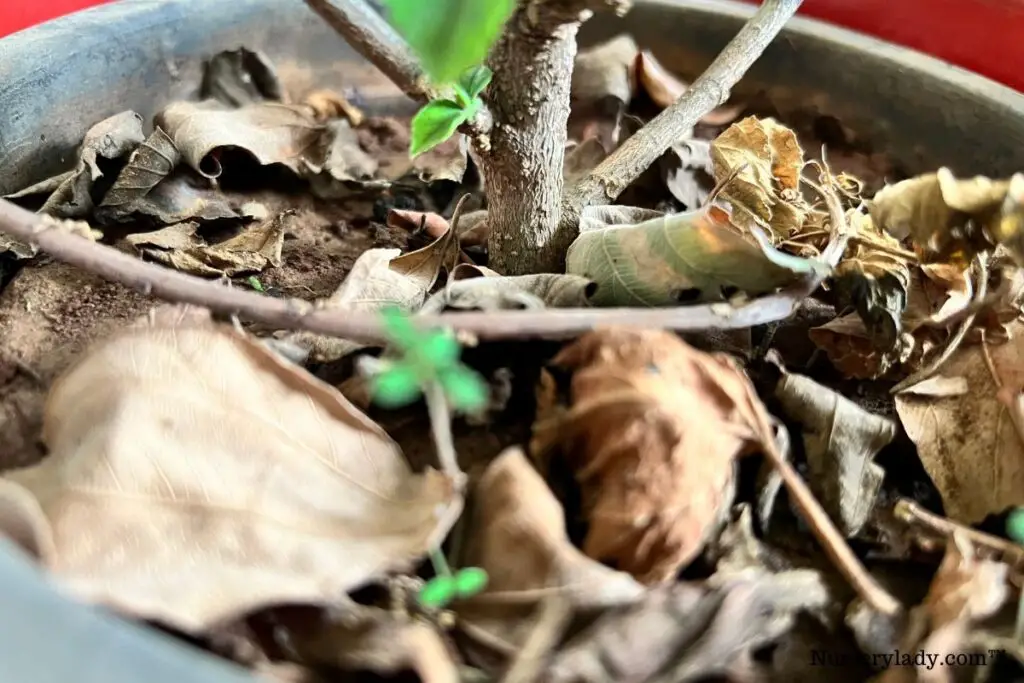Hibiscus plants are native to tropical and sub-tropical regions throughout the world. It enjoys warm temperatures and high humidity. Many gardeners mist their plants to maintain suitable humidity. But does Hibiscus like to be misted? Let’s find it out.
Due to their demand for high humidity levels, Hibiscus loves to be misted. However, there are other ways to increase the humidity as well. But remember, high humidity and lack of air circulation will promote fungal development. So, you should ensure proper ventilation.
Hibiscus will undergo different problems if the humidity levels drop below 50%. This article will explain how misting helps and other ways to maintain the right humidity for them.

Do Hibiscus plants like to be misted?
Belonging to the tropical regions, Hibiscus would love misting because they enjoy high humidity levels.
However, it will not help much if you live in a drought area.
You have to approach some other ways to increase the humidity.
There can be a rise in problems when you increase the humidity level of Hibiscus.
There has to be enough air circulation.
Otherwise, if the water you mist stays in the leaves and doesn’t dry out, it will increase the leaves’ moisture and cause infestations.
In such a case, add some neem oil to water and then use it for misting.
This will help to prevent pest and fungus infestation.
Along with maintaining high humidity, you must provide adequate ventilation around the plant.
All the gardeners don’t agree with misting.
Some of them speak for misting, and some say against it. Let’s learn the merits and demerits of misting.
What are the pros and cons of misting?
| Pros | Cons |
|---|---|
| It helps to increase the humidity by around 10% to 15%. | It works for a short time. |
| You can also clean the leaves by misting them. | It is not enough if the surrounding climate of your plant is dry, especially during the winters. |
| It provides extra hydration to the plant. | Using tap water directly for misting will only lead to the accumulation of harsh minerals, which can further hurt the plant. |
| Misting with neem oil can prevent all sorts of infestations. | If the water doesn’t dry out, it can invite unwanted guests like fungus and pests. |
When and how to mist the plants?
There is no fixed day to mist the plants.
You can do it daily with room temperature water to maintain the plant’s hydration and humidity.
The best time to mist the plants is early morning, between 7 and 9 am.
Again you can do it in the evening after 5 pm.
The stomata remain open at these times.
The plant will absorb the moisture at ease.
- Fill a spray bottle with distilled water or rainwater. If you use distilled water, you can add some hydrogen peroxide to make it pure rainwater.
- Never use tap water directly. If you must use it, let it sit for one night for the minerals to evaporate.
- Spray the water thoroughly over the plant, all sides of the leaves, stalks, and branches.
- If you use Neem oil while misting, don’t do it in the morning. If the plant is under the direct sun during neem oil treatment, it will burn the leaves and harm the plant’s health.
- To mist the plant with Neem oil, you must always do it when the sun goes down.
Although misting can increase the humidity, it is not the only way available.
Since misting is not always efficient, there are other alternatives that we will discuss later in this article.
They are more effective than just misting.
Does Hibiscus like humidity?

As I said earlier, Hibiscus loves high humidity as they naturally belong to tropical areas where the temperature is warm, the humidity is high, and the soil remains consistently moist.
Hibiscus enjoys moderate to high humidity levels.
In the greenhouse, they receive a humidity level of around 90%.
However, the plant also remains under proper care.
But in your house or garden, don’t maintain such a high humidity because you won’t be able to give them the care and maintenance like the greenhouse.
In general, the humidity level around Hibiscus should not be less than 50%.
You can maintain a humidity level between 50% and 70%.
High humidity is crucial for the plant’s good growth and development.
It helps to maintain the moisture content of the plant.
The plant’s transpiration system depends on the humidity.
If the humidity is low, the stomata will be closed, for which the plant won’t transpire.
As a result, photosynthesis gets affected, and so does the plant’s health.
So, you must provide the plant with its ideal humidity, especially if they are growing in a region where the environment is different from its native land.
Looking for gardening supplies? We have tested 100's of products before recommending them to you guys. Check out our best pick below:
| Image | Gardening Supplies | Best Price? |
|---|---|---|
 Top
Top Top
Top | Raised Garden Bed Kit | Check On Amazon |
 | XLUX Soil Moisture Meter, Plant Water Monitor, Soil Hygrometer Sensor for Gardening, Farming, Indoor and Outdoor Plants, No Batteries Required | No Results |
 Top
Top Top
Top | 82 Pcs Garden Tools Set and Extra Succulent Tools Set | Check On Amazon |
 | Joeys Garden Expandable Garden Hose with 8 Function Hose Nozzle, Lightweight Anti-Kink Flexible Garden Hoses, Extra Strength Fabric with Double Latex Core, (50 FT, Black) | No Results |
 Top
Top Top
Top | Dual Chamber Compost Tumbler | Check On Amazon |
 Top
Top Top
Top | Sunnyglade Plant Stakes | Check On Amazon |
 Top
Top Top
Top | Organic Cold Pressed Neem Seed Oil | Check On Amazon |
 Top
Top Top
Top | Mighty Mint Gallon :-Insect and Pest Control Peppermint Oil | Check On Amazon |
 Top
Top Top
Top | Scotts DiseaseEx Lawn Fungicide | Check On Amazon |
 Top
Top Top
Top | Jacks Classic 20-20-20 All Purpose Fertilizer | Check On Amazon |
 Top
Top Top
Top | 30,000 Seeds Pollinator Attracting Wildflower Mixture | Check On Amazon |
 Top
Top Top
Top | Survival Vegetable Seeds Garden Kit-Over 16,000 Seeds | Check On Amazon |
How do I check the humidity level of the surrounding area?
If your plant is outside, they get exposed to the natural humidity level of the location.
But if you still want to know, use a hygrometer to measure the level.
You can use it for both indoor and outdoor purposes.
Hygrometers are small handy devices specifically designed to measure the humidity level of the surrounding environment.
If your plant is outdoors, every garden side will have the same humidity level.
It generally depends on your area’s temperature, season, and climate.
But indoors, different locations will have different humidity levels.
For example, bathrooms, aquarium rooms, and kitchen will have high humidity than your study room or bedroom.
Signs that your Hibiscus requires more humidity

In their natural habitat, Hibiscus will receive all their requirements naturally.
But, in your place, you have to make some effort to mimic the plant’s natural growing environment to make the plant feel it is growing in its natural habitat.
If the plant fails to get a suitable humidity level, it will end up with signs like:
- Brown edges in the leaves
- Leaves falling off
- Flower buds dropping
- Droopy foliage
These signs can also signify other problems like dehydration, overwatering, or chemical shock.
But, if the plant is not having these problems, it is due to low humidity levels.
Consider checking the humidity level with a hygrometer to confirm the problem.
How can I increase the humidity level for my Hibiscus plants?
If you live in a region with low humidity or humidity fluctuations, you should adjust it by giving the plant its correct humidity levels.
If your plant is outdoors, you cannot fully control the humidity.
But, you can still use a few techniques to increase it.
This is needed mainly during the winters.
High humidity in winters encourages Hibiscus to stay healthy and prevents it from complete dormancy.
It will be easy if you plan to overwinter your Hibiscus plant by bringing it indoors.
There are various ways to provide the plant with the ideal humidity besides misting, and they are more effective than misting.
Below is a list of some effective methods of increasing the humidity for Hibiscus:
Install misting system
Manual misting doesn’t work for a long time.
Additionally, you have to constantly check the condition of the plant and mist the plants from time to time.
Fixing a misting system in your garden near the soil bed will work for multiple tropical plants.
Set a timer, and the misting system will automatically mist the plants from time to time.
In this way, the Hibiscus plants will receive adequate humidity without any repeated effort.
Group plants together
All the plants release moisture that gets lost in the air.
But, if you group these plants with Hibiscus, the moisture released by each plant will substantially increase the humidity of the surrounding environment.
It is comfortable in the case of potted plants because you can easily shift them from one location to another and then again bring it back to their place when required.
However, that doesn’t mean you cannot do it for the in-ground Hibiscus.
If you have any potted tropical plants that enjoy high humidity, bring them close to the Hibiscus plant.
Along with that, consider planting some other tropical plants as companions.
This will not only increase the humidity level but will also give your garden a mini forest appearance.
Mulching

Mulching the Hibiscus plants is beneficial in many ways.
It prevents the moisture level from evaporating and traps it in the soil.
Due to this, the air around the plant will have higher humidity levels than any other plant.
Mulch the soil bed with a 1-2 inch layer of compost or other organic matter.
Other than humidity, it also helps in:
- Preventing soil erosion
- Increasing the fertility of the soil
Create levels with the plant
Arrange your plants and plant them on different levels.
Plant the Hibiscus in front of some tall trees.
When the water droplets fall over the Hibiscus plant, it will increase the humidity level.
This will not only heighten the humidity level but will also keep your soil consistently moist.
So, you can worry a little less about watering.
You can also surround your Hibiscus plants with other large trees.
These will act as a wall around the plant and prevent the moisture from losing from that particular area.
Water trays
Fill some trays with water and keep them around the Hibiscus plants.
As the water evaporates, it will fill in the surrounding air with enough moisture and increase the humidity.
Though any tray or container will work, a shallow and wide tray will amplify the humidity level more than the deep one.
Check the container from time to time and add water when the level goes down.
Pebble trays
This works for potted Hibiscus plants.
Fill a tray with stones and water and keep the potted plant over it.
Make sure that the pots don’t sit on the water.
As the water evaporates, it adds extra humidity around your plant.
Use distilled water or rainwater.
For using tap water, you need to let it sit overnight for the minerals to evaporate.
Direct use of tap water will lead to the accumulation of salts and minerals.
For indoor plants
If you are growing Hibiscus indoors because your region gets cold temperatures, there are 2-3 other convincing ways to increase humidity for indoor Hibiscus other than the methods mentioned above.
Humidifiers
If you don’t want to put so much effort, buy a humidifier suitable for your room and set it in the plant’s room.
This will mimic the exact humidity level for your Hibiscus and won’t drop or rise at any moment.
Maintain a distance of 1 foot between the plant and humidifier.
It will encourage good airflow and prevent the development of powdery mildew or any other fungi.
Aquariums
This is also for indoor set-up.
Place an aquarium in your plant’s room.
As the water evaporates, it adds extra moisture to the air, thus increasing the humidity level around the plant.
The water tray works the same way as aquariums.
You can use the dirty water of the fish tanks as a fertilizer.
The excretion of the fishes makes the water rich in nitrogen, and using this water for Hibiscus can increase the nitrogen level of the plant.
Reduce the temperatures of the room
Cold temperature holds moisture more than warm temperatures.
So, if the temperature of your plant’s room has low humidity levels, you can reduce the temperature of that particular room.
It won’t let the soil moisture dry faster and can keep it consistently moist for longer periods.
Note: Many people forget about an essential factor while improving the humidity levels.
It is air circulation.
It is necessary to check that the plant receives proper ventilation with high humidity, especially the indoor plants.
Otherwise, it will become prone to fungal diseases.
Final thoughts
Native to the tropical areas, Hibiscus enjoys misting daily with lukewarm or tepid water. It helps in adjusting the hydration and humidity levels of the plant.
Hibiscus likes moderate to high humidity levels ranging above 50% and below 90%.
Though the plant receives 90% humidity in the greenhouses, don’t try to mimic this because you might fail to care for the plant as they are taken care of in the greenhouses. So keep the level between 50% and 70%.
The level should not go below 50%. If it does, adjust it by installing a misting system, group planting, mulching the soil with organic matters, keeping water trays around the plant, and creating levels with the plant. You can also use pebble trays for potted plants.
Besides these techniques, use humidifiers or aquariums for indoor plants. You can also reduce the room temperature to slow down the drying out of the soil.
Reference: Wikipedia, ASPCA, Louisiana State University Agricultural Center, American Society for Horticultural Science, Tropical Hibiscus by Texas A&M University, Sciencedirect.
